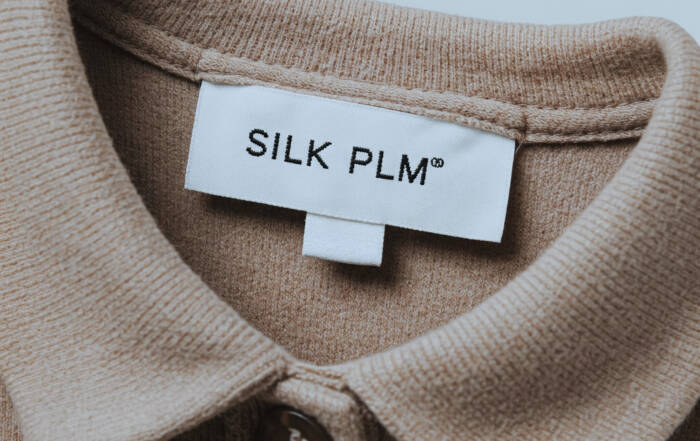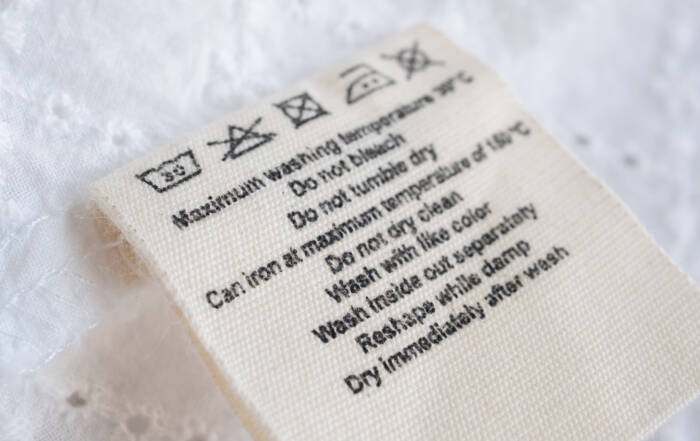Key Types of Clothing Labels: Your Product’s Storytellers
Different clothing labels serve different purposes. Think of them as the little info guides for your garments. Here’s a breakdown of the essential types:
- Brand Labels: Usually placed at the neckline or waist, brand labels showcase your logo, name, or tagline. They’re what make your products recognizable. Think of it like the signature – it validates authenticity and builds your brand identity. Crucial for consistent brand representation.
- Care Labels: These provide vital instructions on how to wash, dry, and care for your garments. Proper care ensures the longevity of your product and keeps your customers happy. Incorrect care can lead to shrinkage, fading, or damage – which can lead to unhappy customers (and returns!) Including clear care instructions on your clothing tag helps prevent customer issues.
- Size Labels: Accurate and easy-to-read size labels help customers choose the right fit, reducing returns and boosting satisfaction. A confusing size chart, or incorrect labelling can put off potential customers. Getting the size right on your clothing tag is essential for good customer experience.
- Material Composition Labels: These labels disclose exactly what your garment is made of (e.g., 100% cotton, 60% polyester, 40% rayon). This is crucial for building trust and caters to customers with allergies or material preferences. Accurate disclosure on your clothing tag is key for building customer trust.
- Origin Labels: Also known as “Made in…” labels. These labels indicate where your product was manufactured.
Compliance and Legal Requirements: No Room for Shortcuts
Clothing labels are often a legal requirement. Regulations vary between regions, and not adhering to them can land your business in hot water, especially if you’re shipping internationally. Here’s what to keep in mind:
Material Composition: Both the EU and the U.S., for instance, have specific rules regarding what materials need to be disclosed and how. Misrepresenting fabric content can lead to hefty fines. Ensure your clothing tag is legally compliant.
Care Instructions: The symbols used on care labels are standardized globally, although certain regions may require specific phrasing. You must ensure these labels are legible and accurate. The care section of your clothing tag should be clear and standardized.
Origin Labeling: In many countries, specifying where your garment was made is mandatory. For the US, for example, this can get very specific on different types of imports. Make sure the clothing tag has all necessary information for legal requirements.
A Word of Caution for E-Commerce Businesses: If you’re selling online and shipping globally, you need to be extra vigilant about these regulations. What’s acceptable in one country might not be in another. Do thorough research and make sure your clothing labels comply with all relevant regulations in your target markets. It might be worth consulting with legal experts in your markets.
Optional and Value-Adding Labels
While some clothing labels are required, others allow you further enhance your products:
Certification Labels: These showcase your commitment to sustainability. Labels like “Organic Cotton,” “Recycled Materials,” or “Fair Trade” can attract customers who are consciously looking for ethical brands. Using certification labels on your clothing tag can improve your brand image.
Promotional Labels: “Limited Edition,” “New Arrival,” or “Best Seller” can create a buzz and encourage sales. A well-placed promotional clothing tag can boost sales.
QR Code Labels: These are excellent for digital engagement. Direct your customers to care tutorials, brand stories, size guides, or your social media accounts. These labels bring a modern, tech-savvy edge to your brand. Modernize your approach with a QR code clothing tag.
Customization and Branding: Making Your Mark
Clothing labels are a fantastic opportunity to elevate your brand. Here’s how you can stand out:
- Custom Woven or Printed Labels: High-quality, personalized labels enhance the perceived value of your products. Woven labels often provide a premium, luxurious feel that is difficult to fake. Choose the right label material for your brand, from a custom clothing tag.
- Heat-Transfer Labels: If you’re after a sleek, minimalist design, heat-transfer labels are a great option. They feel seamless and are perfect for delicate fabrics. A heat-transfer clothing tag provides a minimal look.
Practical Tips for Labeling: Actionable Advice
Here are some practical tips to get your labeling strategy right:
Choosing the Right Materials: Select materials based on your product’s needs, brand aesthetic, and budget. Consider satin, woven, printed, or recycled options. If sustainability is important to you, consider organic, recycled or compostable clothing tags.
Reliable Manufacturers: Team up with a label manufacturer with a proven track record for quality and reliability. Get samples before committing to a bulk order. Make sure the lead time and production capacity work for your business. Partner with a reliable clothing tag manufacturer.
Balancing Cost and Quality: Don’t sacrifice quality for cost. Find the perfect balance to suit your budget without compromising on the look and feel of your brand. Find the right balance of price and quality in your clothing tag.
Conclusion: Labels Matter
Clothing labels are an integral part of your brand story, your customer experience, and your legal obligations. Getting them right is essential for your success. Don’t see them as a checklist item—see them as an opportunity to build trust, create brand loyalty, and communicate your values.
So, take the time to plan your labeling strategy carefully. Invest in quality, focus on compliance, and use clothing tags to reinforce your unique brand.
Fashion Labels: The Essential Guide for Clothing Brands
Fashion labels play a crucial role in your brand and shape how customers perceive your product. If you're launching a new product line and feel unsure about how to select the right labels, this guide will serve as your go-to resource!
Guide to Care Labels for Fashion Brands: Compliance & Sustainability
Care labels are a vital communication tool for customer satisfaction, legal compliance, and reinforcing your brand values. Whether you're a fashion startup, e-commerce business, or independent designer, understanding care labels is non-negotiable.



